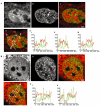Condensed chromatin domains in the mammalian nucleus are accessible to large macromolecules
- PMID: 12947417
- PMCID: PMC1326359
- DOI: 10.1038/sj.embor.embor922
Condensed chromatin domains in the mammalian nucleus are accessible to large macromolecules
Abstract
Most chromatin in interphase nuclei is part of condensed chromatin domains. Previous work has indicated that transcription takes place primarily at the surface of chromatin domains, that is, in the perichromatin region. It is possible that genes inside chromatin domains are silenced due to inaccessibility to macromolecular components of the transcription machinery. We have tested the accessibility of chromatin domains in nuclei of living cells with proteins and dextrans of different molecular sizes. Our results show that chromatin domains are readily accessible to large macromolecules, including proteins with a molecular weight of several hundred kilodaltons. Therefore, the silencing of genes that are incorporated into such domains is not due to the physical inaccessibility of condensed chromatin domains to transcription factors.
Figures



Similar articles
-
Spatial organization of nucleotide excision repair proteins after UV-induced DNA damage in the human cell nucleus.J Cell Sci. 2009 Jan 1;122(Pt 1):83-91. doi: 10.1242/jcs.031062. Epub 2008 Dec 9. J Cell Sci. 2009. PMID: 19066286
-
Nuclear reassembly excludes large macromolecules.Science. 1987 Oct 23;238(4826):548-50. doi: 10.1126/science.2443981. Science. 1987. PMID: 2443981
-
Polycomb group gene silencing proteins are concentrated in the perichromatin compartment of the mammalian nucleus.J Cell Sci. 2003 Jan 15;116(Pt 2):335-43. doi: 10.1242/jcs.00225. J Cell Sci. 2003. PMID: 12482919
-
Perichromatin region: a moveable feast.Histochem Cell Biol. 2018 Sep;150(3):227-233. doi: 10.1007/s00418-018-1703-8. Epub 2018 Aug 3. Histochem Cell Biol. 2018. PMID: 30076463 Review.
-
Mobility of multi-subunit complexes in the nucleus: accessibility and dynamics of chromatin subcompartments.Histochem Cell Biol. 2005 Mar;123(3):217-28. doi: 10.1007/s00418-005-0752-y. Epub 2005 Apr 14. Histochem Cell Biol. 2005. PMID: 15830242 Review.
Cited by
-
Changes to cellular water and element content induced by nucleolar stress: investigation by a cryo-correlative nano-imaging approach.Cell Mol Life Sci. 2013 Jul;70(13):2383-94. doi: 10.1007/s00018-013-1267-7. Epub 2013 Feb 6. Cell Mol Life Sci. 2013. PMID: 23385351 Free PMC article.
-
Molecular crowding affects diffusion and binding of nuclear proteins in heterochromatin and reveals the fractal organization of chromatin.EMBO J. 2009 Dec 16;28(24):3785-98. doi: 10.1038/emboj.2009.340. EMBO J. 2009. PMID: 19927119 Free PMC article.
-
ISWI catalyzes nucleosome sliding in condensed nucleosome arrays.bioRxiv [Preprint]. 2023 Dec 4:2023.12.04.569516. doi: 10.1101/2023.12.04.569516. bioRxiv. 2023. Update in: Nat Struct Mol Biol. 2024 Sep;31(9):1331-1340. doi: 10.1038/s41594-024-01290-x. PMID: 38106060 Free PMC article. Updated. Preprint.
-
Nucleosome dynamics render heterochromatin accessible in living human cells.bioRxiv [Preprint]. 2024 Dec 13:2024.12.10.627825. doi: 10.1101/2024.12.10.627825. bioRxiv. 2024. Update in: Nat Commun. 2025 May 16;16(1):4577. doi: 10.1038/s41467-025-59994-7. PMID: 39803586 Free PMC article. Updated. Preprint.
-
A glue for heterochromatin maintenance: stable SUV39H1 binding to heterochromatin is reinforced by the SET domain.J Cell Biol. 2005 Aug 15;170(4):537-49. doi: 10.1083/jcb.200502154. J Cell Biol. 2005. PMID: 16103223 Free PMC article.
References
-
- Brown K.E., Baxter J., Graf D., Merkenschlager M. & Fisher A.G. ( 1999) Dynamic repositioning of genes in the nucleus of lymphocytes preparing for cell division. Mol. Cell, 3, 207–217. - PubMed
-
- Chubb J.R. & Bickmore W.A. ( 2003) Considering nuclear comparmentalization in the light of nuclear compartments. Cell, 112, 403–406. - PubMed
-
- Chubb J.R., Boyle S., Perry P. & Bickmore W.A. ( 2002) Chromatin motion is constrained by association with nuclear compartments in human cells. Curr. Biol., 12, 439–445. - PubMed
-
- Cockell M. & Gasser S.M. ( 1999) Nuclear compartments and gene regulation. Curr. Opin. Genet. Dev., 9, 199–205. - PubMed
Publication types
MeSH terms
Substances
LinkOut - more resources
Full Text Sources

